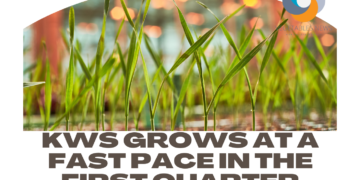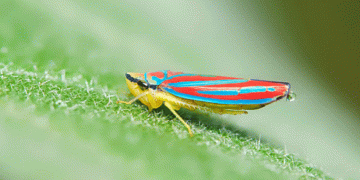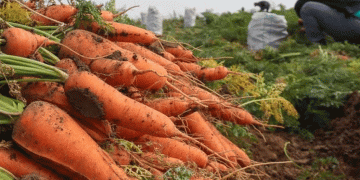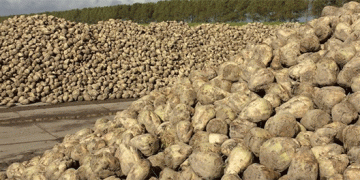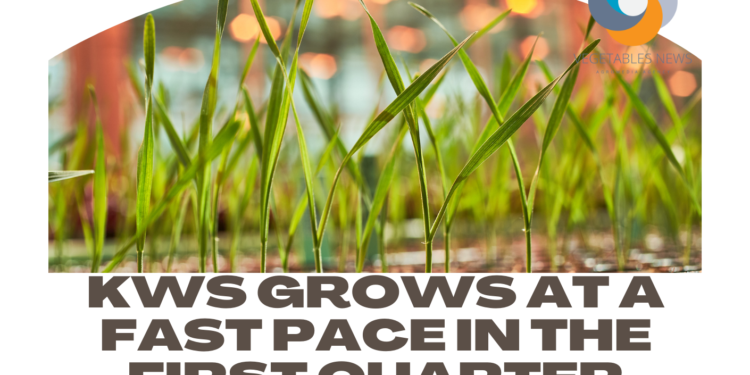Net sales increased by 20% and by 23% on a like-for-like basis – Strong growth in South America – Guidance for the year confirmed
The KWS Group (ISIN: DE0007074007) increased its net sales by 20% to €220.8 million in the first quarter of fiscal 2021/2022. The KWS Group’s key figures for EBITDA, EBIT and net income for the period are typically negative in the first quarter, but they improved year over year. Due to the strongly seasonal nature of our business, the first quarter (July 1 to September 30) contributes only around 15% of KWS’ total net sales for the fiscal year.
“We’ve gotten off to a very dynamic start to the new fiscal year,” said Eva Kienle, Chief Financial Officer of KWS. “Apart from seasonal effects, the overall increase in demand for seed had a very positive impact on our business. We are optimistic about the further course of the year and confirm our guidance.”
Net sales in the period under review rose by 19.9% to €220.8 (184.1) million. On a like-for-like basis, the growth was 23.0%. The key figures for operating income and net income for the period improved year over year: EBITDA was € –19.7 (–27.3) million, while EBIT was € –42.1 (–50.5) million. A significantly improved gross profit was partly offset by increased functional costs for research and development, sales and administration.
Net financial income/expenses came to € –17.2 (–15.2) million. Income taxes totaled € –15.9 (–17.9) million. The result was net income for the period of € –43.3 (–47.9) million and earnings per share of € –1.31 (–1.45).
The free cash flow improved slightly to € –105.7 (–112.1) Million.
Overview of the key figures
| in € millions | Q1 2021/2022 | Q1 2020/2021 | +/- | |
| Net sales | 220.8 | 184.1 | 19.9% | |
| EBITDA | -19.7 | -27.3 | 27.8% | |
| EBIT | -42.1 | -50.5 | 16.6% | |
| Net financial income/expenses | -17.2 | -15.2 | -13.2% | |
| Result of ordinary activities | -59.2 | -65.6 | 9.8% | |
| Income taxes | -15.9 | -17.7 | 10.2% | |
| Net income | -43.3 | -47.9 | 9.6% | |
| Earnings per share | in € | -1.31 | -1.45 | 9.7% |
Business performance of the segments
The Corn Segment grew its net sales by around 52% to €71.2 (46.9) million in the first quarter. Argentina and Brazil, KWS’ main markets in South America, made a major contribution to that and we expanded business strongly in them. Apart from an earlier start to the winter sowing season, greater cultivation area and higher sales prices in Brazil, coupled with the continuing success of KWS’ innovative varieties, had a significant positive impact on net sales. In the regions of Europe and North America, the segment does not generate any significant net sales in the first quarter due to seasonal reasons. The segment’s income was € –40.1(–41.0) million.
The Sugarbeet Segment posts only low net sales in the first quarter due to seasonal reasons. The figure for the quarter under review was €18.3 (16.1) million. The revenue mainly comes from the sale of sugarbeet seed in Chile and North Africa. The segment’s income was € –32.4 million, on a par with the previous year’s figure of € –32.2 million.
Net sales in the Cereals Segment rose by around 11% to €121.2 (109.1) million. The increase was mainly due to sharp expansion in rapeseed seed business (+56%). Apart from favorable market conditions, the improved performance of KWS’ variety portfolio was a further contributory factor. However, sales of rye seed fell by around 5%. The sharp increase in wheat prices has meant that growing rye has become economically disadvantageous in some regions by comparison. Wheat and barley seed business plays a minor role for KWS in the first quarter. The segment’s income rose sharply to €43.1 (36.0) Million.
Net sales at the Vegetables Segment fell year over year to €10.2 (13.3) million. Continued high inventory levels at distributors mean there is still moderate demand for spinach and bean seed at present. Business is expected to pick up in the second half of the fiscal year. As a result of the course of business and further expansion of the Business Unit Vegetables, the segment’s income fell to € –4.5 (–3.3) million. Excluding effects from the purchase price allocation as part of company acquisitions, the segment’s income was €0.4 (3.1) million.
Net sales in the Corporate Segment totaled €2.3 (1.8) million. They are mainly generated from KWS farms. Since all cross-segment costs for the KWS Group’s central functions and basic research expenditure are charged to the Corporate Segment, its income is usually negative. At €–25.2 million, the segment’s income was slightly below the level of previous year (€–22.0 million).
The difference from the KWS Group’s statement of comprehensive income and segment reporting is due to the requirements of the International Financial Reporting Standards (IFRSs) and is summarized for the key indicators of net sales and EBIT in the reconciliation table below:
Reconciliation table
| in € millions | Segments | Reconciliation | KWS Group1 |
| Net sales | 223.2 | -2.5 | 220.8 |
| EBIT | -59.1 | 17.1 | -42.1 |
1 Excluding the shares of the equity-accounted companies AGRELIANT GENETICS LLC., AGRELIANT GENETICS INC. and KENFENG – KWS SEEDS CO., LTD.
Guidance for the 2021/2022 fiscal year confirmed
The Executive Board still anticipates that the KWS Group will grow net sales by 5% to 7%. The EBIT margin is expected to be around 10% and in a range from 11% to 12% after adjustment for the noncash effects from purchase price allocations as part of company acquisitions. R&D intensity is expected to be in the range of 18% to 20%.
Annual General Meeting 2021 in virtual format
The Annual General Meeting of KWS SAAT SE & Co. KGaA will take place on December 2, 2021 from 11:00 a.m. (CET) in virtual format. The documents and further information on the Annual General Meeting are available at www.kws.com.
